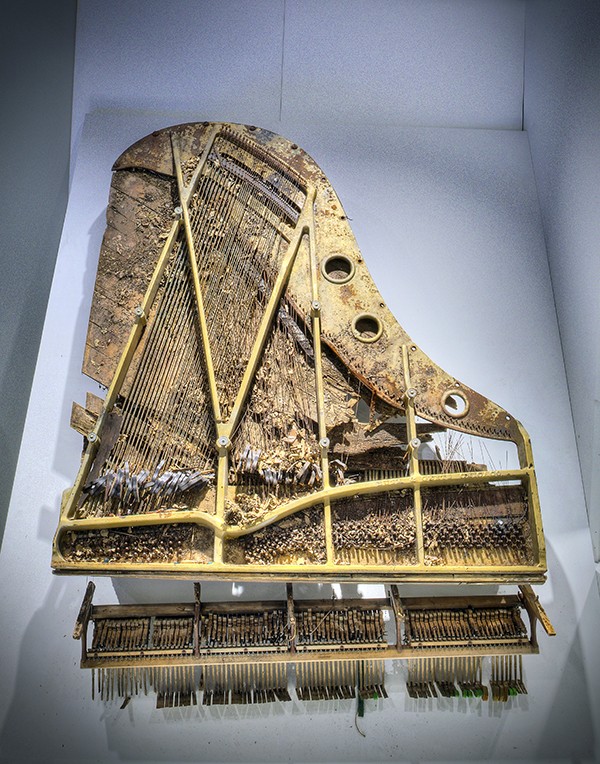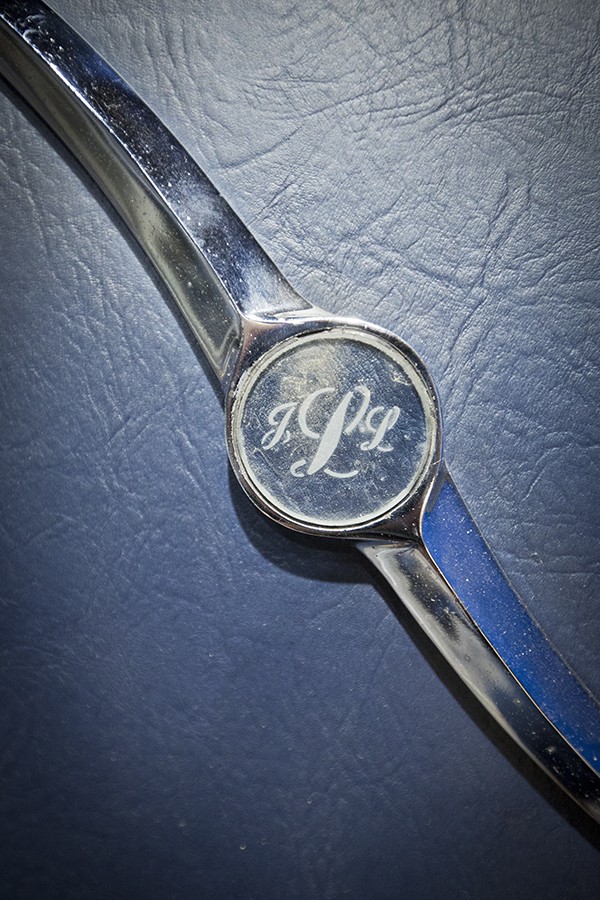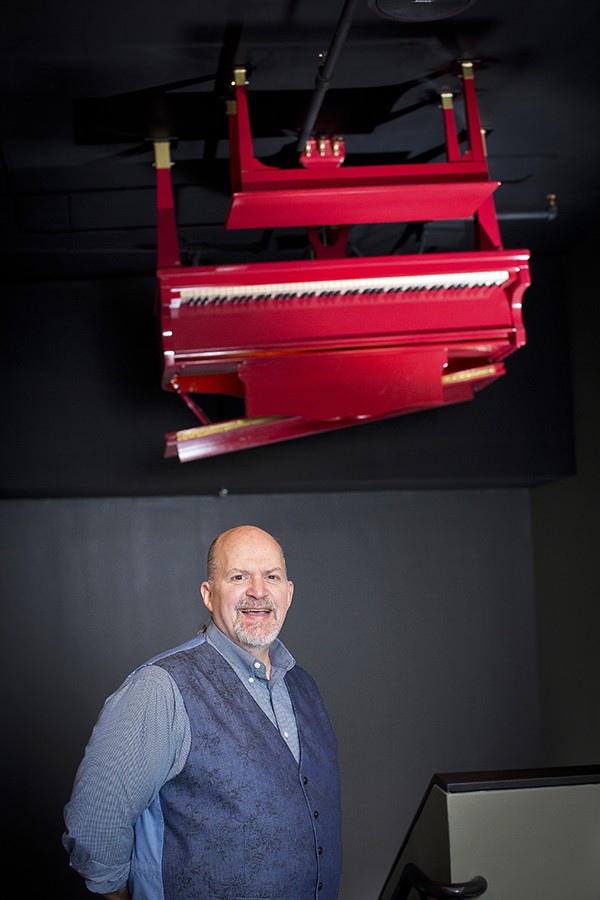“I have gladly given my life to Memphis music, and it has given me back a hundred-fold. It has been my fortune to know truly great men and hear the music of the spheres. May we all meet again at the end of the trail.” — Excerpted from the last words of Jim Dickinson.
 Justin Fox Burks
Justin Fox Burks
The ceiling of the hallway leading to the museum’s second-floor space is lined with guitars that point the way to the exhibits.
Jim Dickinson liked to “watch shit rot.” Those are Dickinson’s own colorful words, of course. The storied producer, musician, Memphis Music Hall of Fame inductee, and provocateur, always placed “decomposition” at the heart of his personal aesthetic. He believed you could hear the sounds of decay in the songs he recorded with Alex Chilton and Big Star. You could see it represented visually in the paintings he labored over, then left outdoors for nature to complete.
Until very recently, visitors to Dickinson’s Zebra Ranch recording studio, were encouraged to touch a broken-down piano decomposing in the yard. In its former life, the crumbling instrument, propped up on cinder blocks like some old jalopy and covered in filth and leaves, had belonged to the Stax recording studio. It was in the building when Isaac Hayes and David Porter were songwriting partners cranking out hits like “Soul Man,” and “Wrap it Up.” It was there when Booker T. and the MG’s was the Stax house band, and when Otis Redding wrote “(Sittin’ On) The Dock of the Bay.”
Dickinson’s widow, Mary Lindsay Dickinson, says some people understood her husband’s fondness for decay. It also made a lot of people angry to see a beautiful piece of music history left out in the weather to fall apart.
 Justin Fox Burks
Justin Fox Burks
Jim Dickinson’s piano detail.
 Justin Fox Burks
Justin Fox Burks
Jim Dickinson’s piano
John Doyle, executive director of the Memphis Rock ‘n’ Soul Museum, describes what’s left of the old Stax piano as, “a piece of Jim Dickinson’s soul.” He says it’s a perfect example of the kinds of things a visitor can expect to find on display at the Memphis Memphis Music Hall of Fame museum, which opens for business this week at the corner of Second and Beale, in a cozy two-story space nestled between the newly relocated Hard Rock Cafe and Lansky Bros. Clothier to the King. The exhibits are primarily on the second floor, where the Lansky brothers once stored their formal wear. It’s the place where Johnny Cash was taken after he came to Bernard Lansky brandishing a Prince Albert tobacco tin, wanting to buy a black frock coat just like the prince’s. “That may be the beginning of the ‘Man in Black,”‘ Doyle speculates.
 Justin Fox Burks
Justin Fox Burks
John Doyle, Executive director of the Memphis Music Hall of Fame, shows off a few of the museum’s treasures including Jerry Lee Lewis’ Cadillac, Johnny Cash’s black suit, and an original Elvis jumpsuit.
Although the two museums share administrative staff, the Memphis Music Hall of Fame isn’t Memphis Rock ‘n’ Soul Museum Jr. The latter Smithsonian-affiliated museum, located in the FedExForum, has been telling the story of Memphis music for the past 15 years. The Memphis Music Hall of Fame has only been inducting members since 2012. Its new brick-and-mortar facility will give visitors a chance to spend some digitally interactive quality time with the legendary heroes of Memphis music.
 Justin Fox Burks
Justin Fox Burks
A customized emblem on Jerry Lee Lewis’ Cadillac.
“I asked myself, if I had the opportunity to hang out with the musicians we’re inducting each year, what would that cocktail party be like?” Doyle says, explaining his vision for the Hall of Fame exhibit. “I’m pretty sure it would not look like the Smithsonian. It would probably be weird. So we’re positioning the Memphis Music Hall of Fame as a museum where our exhibits are as outrageous as our inductees.”
 Justin Fox Burks
Justin Fox Burks
John Doyle, executive director of the Memphis Music Hall of Fame, discusses the layout of a large case with Pam Parham, director of operations.
That explains decorative touches like a ceiling hung with St. Blues guitars and the full-sized piano suspended upside down and transformed into an enormous light fixture. That’s also the philosophy behind both Dickinson’s decomposing keyboard, and a lifelike python built to accompany Larry Dodson’s costumes in the eye-popping Bar-Kays exhibit.
 Justin Fox Burks
Justin Fox Burks
John Doyle, executive director of the Memphis Music Hall of Fame, stands art the top of the stairs where a glowing piano stands in for a traditional light fixture.
“In Europe, they’re protecting Rembrandts,” Doyle says. “In Memphis, we’re protecting a pink shorts set with a cape that Rufus Thomas wore at WattStax. It is the funkiest-looking thing ever. But in Memphis it becomes an art museum treasure.”
Additional treasures collected in the Hall of Fame include an acoustic guitar that belonged to Memphis street sweeper and blues legend Furry Lewis. The well-documented guitar is on loan from a North Dakota collector, as is the original guitar case on which Lewis painted his name.
The seeds that grew into the Memphis Music Hall of Fame were planted in 2007, when Doyle asked his Rock ‘n’ Soul board to brainstorm new ways for the museum to enhance its mission to tell the Memphis music story and grow beyond the walls of the FedExForum. It was Memphis Convention & Visitors Bureau President Kevin Kane who first suggested the idea of opening a hall of fame. The concept was an immediate hit, although nobody seemed to know for sure what form such an entity might take. “It could be a chicken dinner we have every year, with special performances and trophies,” Doyle says. “It might be a public art installation somewhere downtown. Or a comprehensive website with music and pictures.” Doyle thought a new off-site exhibit would be cost-prohibitive. Then, about a week after the hall’s first induction ceremony, Memphis Mayor A C Wharton approached the Rock ‘n’ Soul director with news that Beale Street’s Hard Rock Cafe was moving from its original location on the eastern stretch of Beale, into the old Lansky’s building. The club, Wharton said, was looking to partner with a museum.
“As the executive director, my heart sank,” Doyle jokes. “I could tell this was going to mean a lot of work.” With nearly six million visitors annually, Beale Street is Tennessee’s largest tourist destination, and although it’s home to the W.C. Handy House and Museum, there’s no visitor center where people can find out about the Memphis Zoo or the Stax Museum of American Soul Music or the newly opened Blues Hall of Fame on South Main or anything else.
“We felt like we could assist in doing all that by having a presence here,” Doyle says. Between the licensing appropriate music and photos and the hiring of top-notch music writers and designers, the Memphis Music Hall of Fame’s website was costing the Rock ‘n’ Soul museum $90,000 a year. “That’s a good-size burden for a not-for-profit museum,” Doyle says. “Fortunately, because of our relationship with the Memphis Grizzlies and because of our location at the FedExForum, we’ve been able to sustain that and grow our mission outside the walls they provide for us.”
Even in a tourist-rich zone like Beale Street, that kind of “assist” might not sound like a big deal. But Memphis music tourism is already on the rise and Elvis Presley’s Graceland Public Relations Director Kevin Kern thinks the new Hall of Fame will only help to promote that upward trend. “[It] will add to our story, while expanding the list of options for the traveler to keep them in town,” Kern says. Memphis, he adds, has finally grown into something “more than a long weekend destination.”
More than 600,000 tour Graceland annually, making it Memphis’ second largest music-related destination after Beale Street, and the second-most-visited residence in America after the White House. More than 150,000 people visit Sun Studio annually, and another 60,000 tour the Rock ‘n’ Soul museum and the Stax Museum of American Soul Music.
Tim Sampson, communications director for the Soulsville Foundation, agrees with Kern. “Our attendance at Stax is way up,” he says. “We’ve got people here in the museum from every continent every single day.”
Sampson welcomes the new Memphis Music Hall of Fame, just as he welcomed the Blues Hall of Fame, which opened in May. He credits the recent boom in music tourism to the fact that music-related destinations are more collaborative than competitive. He also believes that additions to the landscape such as music-related murals and an increasing number of historical markers and museums also help the Memphis tourism industry.
Memphis Rock ‘n’ Soul hit 60,000 tourists annually in 2013, and had its best month ever in April. Each subsequent month has broken previous records. Doyle thinks this is strong evidence that the stage is perfectly set for a facility like the Memphis Music Hall of Fame.
“There is no other city in America that can host its own music Hall of Fame,” Doyle boasts. “Some states can. Alabama has one. Texas has one. But Memphis is the epicenter of American music.
“When we first sat down and started coming up with the names of potential inductees it was so easy,” Doyle says. “There was Jerry Lee Lewis, Elvis Presley, Otis Redding, Rufus Thomas, Al Green, Isaac Hayes, The Staple Singers, and on and on. In that first evening, we listed 300 well-known performers from different musical traditions — jazz, blues, rural field-holler-type music, jug bands, rock ‘n’ roll, rockabilly, gospel, R&B, rap, hip-hop. In a very short time, our list of potential inductees became enormous.”
On the morning before his latest documentary, Best of Enemies, was scheduled to screen in Los Angeles, author and Memphis music historian Robert Gordon offered some perspective regarding the potential of a Memphis Music Hall of Fame compared to other music towns.
“Lots of cities can say they’re home to a star,” he said. “Buddy Holly’s from Lubbock, Texas, for example. And so is Waylon Jennings. So they can make a little Buddy Holly shrine in Lubbock. But Memphis? What decade do you want to talk about? What musical genre?
“People ask how can it be possible that Carl Perkins wasn’t selected until the third year of the Memphis Hall of Fame?” says Gordon. “He’s the first guy to have a number-one record on the pop, country, and R&B charts at the same time,” Gordon says. “And that frustrates some people. It’s something we should celebrate. Our music history has been so rich that we can not induct Carl Perkins until the third year, because each year we’ve wanted to recognize our musical diversity.
“What I want to know is, when will Booker Little get into the Hall of Fame?” Gordon asks, rhetorically. Even though Little died young and his name isn’t a household word, his contributions were significant. It may be next year or 10 years from now, but the Manassas graduate and hard-bop trumpet innovator who performed alongside John Coltrane will eventually be enshrined alongside the better known heroes of Sun, Hi, and Stax.
The answer doesn’t matter, Gordon finally concludes, because the Hall of Fame isn’t a popularity contest.
In a telephone interview, Mary Lindsay Dickinson remembered the day the big truck with “Amro” painted on the side pulled up to the family’s Zebra Ranch recording studio in Coldwater, Mississippi. It had come to take her late husband’s special piano to its final resting place in the Memphis Music Hall of Fame. “There are no better piano movers in the world, I don’t think,” she said. But in spite of their expert handling, the wooden portions of the once-fine instrument fell into shreds as the movers lifted it from its resting place. “It had rotted completely,” Dickinson said, unable to conceal her delight that her late husband Jim had gotten exactly what he wanted.
Spooner Oldham, the great keyboard player, known for his work with Bob Dylan and Aretha Franklin, described Dickinson’s piano as the perfect metaphor for both mortality and immortality. He told Mary Lindsay that even when the wooden bits on the outside had returned to ashes and dust, “there will still be a harp inside.”
“And a harp is what was left,” Dickinson said, reiterating Doyle’s desire to collect edgy artifacts. “The harp was left. And when it finally goes up in the hall of fame it will be the oddest, ugliest, and most unique exhibit in any museum anywhere in the world.”
The Memphis Music Hall of Fame opens to the public on July 27th at 126 Second. Hours of operation will be 10 a.m.-7 p.m. 205-2532 memphismusichalloffame.com/

